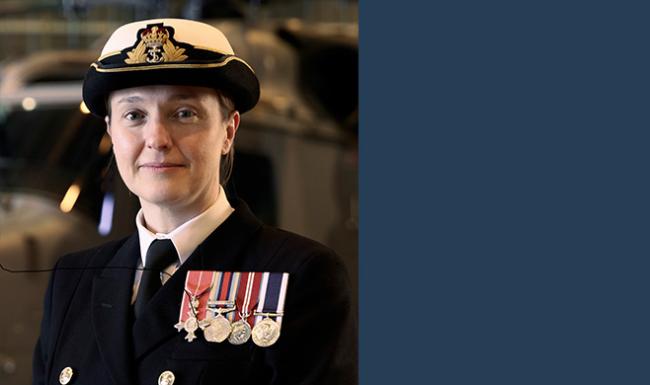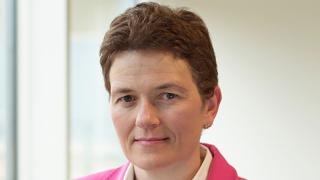Women Influencing Change in Engineering
Written by Captain Caroline Dix MBE
Caroline is an Air Engineer Officer in the Royal Navy, she has served for almost 19 years, her career highlights have included bringing the Wildcat helicopter in to front line service for the Royal Navy, being the Merlin helicopter Mechanical Engineering Authority and being the Chief Engineer of the Royal Navy Air Station at Yeovilton, she is currently a Captain serving as the Military Advisor to HM Treasury.
When I joined the Royal Navy as an Air Engineer Officer at the age of 24, having done an engineering apprenticeship and a Masters in Engineering, I had not even considered that it wasn’t a job that women ‘did’. I was lucky, I was from a family of engineers, both my Mum and Dad (and both grandfathers) were engineering graduates and the talk around the dinner table had been intimidating for many of the unsuspecting young men my sister and I had invited to tea over the years. We hadn’t blinked an eye at it, and only giggled at their discomfort! Even when I was one of 5 women on my degree course of over 100 at Bristol Uni in 2000, I didn’t think about it, I was definitely lucky.
With 24% of engineering graduates in the UK being women[1], we are falling behind the rest of the world where over 28% of engineering grads are female, and those that start in the profession are not staying.
Statistics show 57% of women drop off the roster of professional engineers by the time they reach the age of 45, as opposed to only 17% of men[2]. These statistics appear as though they are being played out within the Military too, but the problems we face could be viewed as much more acute; with an ambitious target of achieving 30% of women in the recruiting intakes across all trades[3], there is a significant challenge facing the engineering cadres not only in recruiting, but also in making the engineering profession one that women want to stay in within the RN.
As I write today, I see my own engineering cadre facing a watershed moment, I understand that there is less than 10% of women at non-commissioned level, and the majority of those are leaving prior to achieving a level associated with being a senior supervisor. Something fundamental needs to be recognised more widely and intensely about women in engineering to ensure that we can bring change that is meaningful and long lasting. This is a conversation that has been happening for years, but what we have done so far doesn’t seem to have made a difference, and the answer isn’t ‘women just don’t want these jobs’, many do, and many would, what we aren’t asking as a society is ‘why aren’t you going for them?’.
My mantra is that whilst I can help to shape and influence the big picture, the most impact I can have as a leader is by working with those most adjacent to me, this is a truism for us all regardless of our sector and by many of us taking ‘small steps’ the influence we can have and the change we can bring is significant; this is regardless of our gender. So here are my thoughts on how we can help make this change, they are thoughts from my own experience, and most importantly, not all women will think the same!
Role Models. We hear so many times that we need role models, but the greatest challenge is that ‘we can’t be what we can’t see’. So, if you are working with women who are likely to be the ‘first’, those that are the minority, or the ‘only’ at the table, then you have a responsibility to support them. Like their counterparts they will make mistakes and need to learn and grow, but they may also feel the pressure and scrutiny more acutely, so your support could be immensely valuable. Most importantly we need to realise that young women can be rightly ambitious and this ambition doesn’t need to change (as I was told) “when you get married and have children”, and that ambition doesn’t have to be born of seeing other women succeed, whilst this helps, success can come through support and encouragement and challenge of both male and female colleagues and seniors.
So what can you do? I ask that you support girls and women to strive for success in STEM subjects, and throughout their career give support, coaching and challenge to help them reach their potential, whatever that is. What I would ask you to also consider is, just as for men, don’t assume you know what each women wants (we are all different and no, you’re no Mel Gibson!)!
Create the right workplace. The inability to retain women in engineering points to a culture that is not conducive for women, this is highly likely to be multi-factorial and potentially not easily changed. But what I would ask is for you to take a moment, and to take one often, to think about and reflect on your workplace:
- Who is doing the talking?
- Who is talking the loudest?
- Is there space for constructive conversation?
- Do you enable a safe questioning culture?
- Is there a coaching environment?
- Are people forming a team or are they a group of competing individuals?
The experience of feeling on the outside of a group, of not being able to ask questions or challenge without snide comments or worse, laughter, can all make women (and men) not enjoy work, and encourage them to leave. So empower your team, BUT keep in touch, coach, challenge through constructive feedback, ensure you give your time and celebrate learning opportunities. Most importantly call out bad behaviour whatever your position, but especially as a leader. We know that the very best outcomes come from diversity in a team, but without the space to challenge and grow improvement will be stifled, and this will create a negative environment.
Organisational Change. Within the Armed Forces there are large moves to make the environment better for women, from the recruitment targets I have already talked about, to an improved focus on women’s health, improvements to uniform, increasing focus on workforce ‘climate’, improved offers for childcare, and a zero tolerance of sexual harassment. At an organisational level driving change remains fundamental to ensuring our workplaces enable the very best our women in engineering have to offer. But championing change at the lower level remains key to enabling acceptance of both the change, and the need for change. In a world where social media buffets us, we need to maintain strong voices.
The bottom line is the greatest truth; the changes that will continue to make the workplace better for women will also improve the workplace for others, improving the outcomes for all, across all areas of business and this is especially true in professions such as engineering where women remain woefully underrepresented.
[1] The Engineer: https://thecircularboard.com/women-in-engineering-statistics/
[2] Royal Academy of Engineering
[3] https://www.gov.uk/government/news/defence-demonstrates-significant-progress-made-for-women-in-the-armed-forces--2
Disclaimer:
The views expressed in Blogs, Articles, Podcasts and Videos posted on Windsor Leadership’s website and social media channels, remain the opinions of the individuals and do not necessarily represent the views or opinions of Windsor Leadership. Windsor Leadership does not accept any responsibility for the accuracy of the information shared. We hope however that the views prove to be useful in reflecting on the challenges of leading today.
Latest blogs
When leadership comes at a personal cost
In this personal blog post, Barry Joinson, Windsor Leadership Facilitator, explores the importance of maintaining clear boundaries between work and home, and how they can help to create clarity, safety, and trust.
Navigating the Boardroom: Professional Insights from Both Sides of the Table
In this blog, Emma FitzGerald explores the critical dynamics between Chairs and CEOs across commercial and not-for-profit sectors, emphasising the importance of trust, defined roles, and collaborative governance in driving organisational success.
The Power of Year-End Reflection
In this blog, Liz Ward, Windsor Leadership's Alumni Relations Manager, shares why reflection can be useful as the year draws to a close. Rather than rushing into new goals, taking time to pause and review successes, challenges, and lessons learned can strengthen clarity, team alignment and long-term vision.
Disclaimer:
The views expressed in Blogs, Articles, Podcasts and Videos posted on Windsor Leadership’s website and social media channels, remain the opinions of the individuals and do not necessarily represent the views or opinions of Windsor Leadership. Windsor Leadership does not accept any responsibility for the accuracy of the information shared. We hope however that the views prove to be useful in reflecting on the challenges of leading today.




